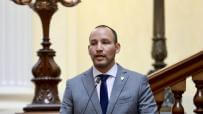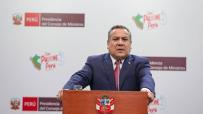
In September 2023, after the Venezuelan military carried out a major operation against illegal gold mining in Yapacana National Park, many miners crossed the border into Colombia and fled to a nearby location in search of better luck. It is not known how many, but several arrived —or returned— to Puerto Inírida, the capital of the Amazonian department of Guainía, in the far east of Colombia. The Attorney General's Office registered 160 displaced families and, according to an indigenous leader, many more mining dredges appeared on the Guainía River. The total exodus from the Yapacana mines was about 14,000 people.
In Guainía —which can only be reached from Bogotá by plane or by river— people, food, motorcycles, wood and solar panels travel in canoes and it was not always a territory burdened by illegal mining. Before the 1980s, the indigenous communities of this territory had never known gold mining. But in recent years, despite the existence of protected natural areas in the area, illegal extraction has intensified.
In this department of the Colombian Amazon, at least 1,565 kilos of gold were extracted between 2015 and the first quarter of 2023 alone. Mining ponds have grown and a United Nations report estimates that 95% of this mineral was extracted illegally.
"Today they are 'repelling' the territory with dredges. And we are involved in this system, working with them, because here, gold moves everything," says a leader of the Curripaco indigenous people. "Mining arrived with white people; some Brazilians and others from the middle of the country. They came down the river with dredges and spread. Nobody stopped them," he says. Like him, 80% of the population of Guainía is indigenous.
What is the route of the illegal gold extracted from Guainía? What are the cracks in this market that also finances illegal armed groups? El Espectador —as part of the OjoPúblico Cross-Border Network— traveled to this department to investigate the pieces of this puzzle.

POLICE OPERATION. In October 2023, the Ministry of Defense conducted an intervention against the illegal exploitation of mining deposits in the Guaviare River.
Photo: Colombia's Defense Ministry
There is one figure that helps to gauge what is happening with Colombia's opaque gold market. The analysis of a database of gold exports from Amazonian countries —constructed as part of the Amazon Dirty Gold investigative series—, reveals that between 2014 and 2023 Colombia exported more than 115 tons of gold of unknown origin.
This amount, however, is conservative. Reports from official sources estimate that 80% of the gold produced in Colombia is illegal.
The Attorney General's Office, according to information accessed by El Espectador for this investigation, is trying to understand the reasons for this huge gap. It is currently investigating several of the main Colombian gold exporting companies, including CI Metales Hermanos, which has links to the extraction of gold in Guainía.
This same authority points out that it has similar evidence for two other trading companies —CIJ Gutiérrez and Goldex— which were investigated a few years ago for allegedly having fictitious suppliers and front companies to launder the gold they exported. According to the prosecutor's office, a large portion of that gold came from illegal deposits, such as those that exist today in the Amazon, and was then incorporated into the legal and global market.
The analysis of images captured in overflights carried out by the Amazon Regional Alliance for the Reduction of the Impacts of Gold Mining —which brings together organizations such as Amazon Conservation Team, Gaia and WWF— shows the widespread presence of mining dredges stirring up rivers and making their way through the middle of the Colombian Amazon, and along the borders with Peru, Brazil and Venezuela.
In the case of the border with Venezuela, where a team from El Espectador traveled, one of the points where mining has spread the most and has triggered alerts among environmental authorities is the Atabapo River. This body of water is part of the Fluvial Star of Inírida, a wetland complex of more than 250,000 hectares of international importance (known as a Ramsar site), where all types of mining are prohibited.
Guainía is also home to the National Puinawai Natural Reserve, a biological corridor that connects the savannahs of the Orinoquía with the Amazon rainforest and some of the oldest rock formations on Earth. The entire department is part of the Amazon Forest Reserve. That is to say, it is designed, almost in its entirety, for conservation.
But there is one aggravating factor. Illegal gold in Colombia ends up financing illegal armed organizations. A 2021 report by the Department against Transnational Organized Crime of the Organization of American States (OAS) confirms that gold has become a source of financing for these groups. An investigation by OjoPúblico shows that in several regions of Colombia, illicit mining accounts for more than 50 percent of the total economy of criminal groups.
The unknown origin of 115 tons of gold
To get to the Atabapo River, on the border with Venezuela, we embarked in Puerto Inírida at five in the morning. It is November 2023 and, after an hour's journey, we find the first evidence of mining: a couple of long canoes occupied by men, loaded with blue plastic containers that usually contain up to 200 liters of fuel. A few meters further on, the first dredges appear: floating structures with palm roofs, an engine, hoses, fuel, hammocks and about 10 men.
"That's where they live, the administrator, the motorist, the hose driver, the divers and only one woman, the cook. They work day and night for months, sucking up the riverbed to extract the gold," explains Carlos*, an indigenous man from the area who worked for more than seven years as an illegal miner.
It is a place where "everything is traded in gold," he says. "One part is for the workers, who receive between one and two grams per day. Another is for the indigenous community through which they travel (because 90% of Guainía is an indigenous reservation); another is to pay for fuel, food and the 'vacuna' [payment] to the armed groups that operate in the area. The owner of the dredge [who is not usually indigenous] also keeps a part," he explains. If there is anything left over, it is for supplies and profit.

TERRITORY. In Guainía, more than 80% of the population is indigenous. A family fishes in the Atabapo River, a critical point for illegal mining.
Photo: Sebastián López Ramírez

OVERFLIGHT. Images at the border with Brazil, on the Puré River, Department of Amazonas, show the progress of mining.
Photo: Amazon Regional Alliance for the Reduction of Impacts from Gold Mining
Pablo Willan Acosta, who was mayor of Puerto Inírida until January of this year, is blunt in recognizing what is happening in his city: "Mining is an informal activity in the municipality, but it is no secret to anyone that it is what really boosts the economy".
For his part, the director of the National Mining Agency (ANM), Álvaro Pardo, points out that informal mining, together with illegal and criminal mining, is a "structural problem of the industry" that grows every time the international price of gold soars.
Pardo acknowledges that the Agency has encountered people who reported gold extracted from a legal title, when, in fact, they had mined it from another area. Or gold that is declared under names of people who were listed as dead.
There is no clear mechanism for gold traceability in Colombia. In theory, each gram that is exported should leave a paper trail that allows knowing the precise point where it came from. In this way, foreign companies can be certain that it did not come from an illegal deposit, and the National Tax and Customs Directorate (Dian) could also ensure that each actor pays taxes. But the figures analyzed for this research show that this process is not working as it should.
Where Colombian gold is going
An analysis of the export database —built as part of the investigative series Amazon Dirty Gold— reveals several inconsistencies. One of the most alarming is that, between 2014 and 2023, Colombia sent abroad more than 574 tons of gold, but at least 115 of those had no known origin.
Between 2014 and 2016, according to official figures, less was exported than was produced, but from 2017 to 2023 the quantities exported were much greater than the country reported producing.
The country that imports most gold from Colombia is the United States. Between 2014 and 2023 it bought 232 tons. In second place is Italy, which did not have a significant share before 2019, with 88 tons. Then there's Switzerland which bought 67 tons, although that's less than it has previously bought.
One more factor shows the complexity of this market. Of the top 15 gold exporting companies in Colombia (which together concentrate more than 72% of gold exports since 2014) there are at least three companies with ongoing criminal proceedings in the Prosecutor's Office for money laundering: CIJ Gutiérrez, CI Metales Preciosos de Colombia and CI Metales Hermanos.
Some of them, such as CIJ Gutiérrez, the country's largest exporter, and CI de Metales Preciosos de Colombia (Meprecol), have been expropriated, which means they were seized by the government for being used, directly or indirectly, in illicit activities. They are currently managed by a state entity: the Special Assets Company (SAE). Between 2014 and 2023, these companies have sent, respectively, 83 tons and 48 tons of gold abroad.
CI Metales Hermanos, another of the main Colombian gold exporters, is in the same situation. According to the Attorney General's Office, between 2009 and 2015, this company made fictitious purchases from non-existing persons and inflated its transactions in order to certify the origin of the gold. Some of them, according to the file accessed for this investigation, were made on behalf of the inhabitants of an indigenous reservation called Chorrobocón, in Guainía. When consulted about this, the community said that they did not recognize these sales.
"A few years ago some gentlemen and their lawyers came and asked us for signatures because they had seized a few kilos of gold. They came to the community because we were the only ones on a mining area. Then, they came to ask them to sign a paper stating that the gold was extracted here and sold to them," explains the captain of Chorrobocón, the community's highest authority. "They offered 10 million pesos [about USD 2,600], but the authority at that time did not accept it," he says.
Although Chorrobocón was the first Indigenous Mining Zone to be formalized in the country in the 1990s, it does not currently have valid mining titles, having lost them in 2006 for not keeping accounting records of the gold it extracted. However, as its captain also confirms, gold continues to be extracted informally in the rivers.
Money laundering paper trail
In the 20 streets that make up the urban area of Puerto Inírida, only one store has a large sign that says "sell gold." It is accompanied by the NIT, the identification number that proves it is a registered business. But it is not the only place where gold is traded. In this small town that makes its way through the Amazon jungle, there are more than a dozen jewelry stores and shops engaged in the same activity.
In the back of one of these places where gold is traded without major controls, there is a small furnace, which reaches temperatures of up to 1200 °C. There, a man behind the counter explains how they melt the grams they buy from the different miners. Both those who are registered as "subsistence miners" —a category created by the Colombian State to recognize and formalize artisanal miners— and those who work in the dredges.
According to the National Mining Agency's (ANM) Single Registry of Traders, there are 1,556 registered subsistence miners in Guainía. All of them are prohibited from using machines, explosives or underground activities. And none of them can extract more than 420 grams per year.
Although there are some that comply with the regulations, investigations by the Attorney General's Office to which El Espectador had access, as part of OjoPúblico's Cross-Border Network, reveal that this registry has been used to launder gold. A source from the Attorney General's Office who requested anonymity explained the mechanism for laundering the illegal ore: "it is laundered when the gold is passed off as gold extracted by barequeros or subsistence miners," he explained.

OVERVIEW. Aerial image in Puerto Inírida, capital of the Department of Guainía. Most of the supplies that arrive or depart from here are transported by river.
Photo: Sebastián López Ramírez
He also clarifies that when the supposed subsistence miners exceed the production ceiling established by law, they register family members or friends in the system, despite the fact that they do not carry out the activity. "At the Mining Authority there is no way to verify that this gold is legal. There is a flaw in the system," the source said.
Despite this evidence, Álvaro Pardo, director of the Mining Authority, says that it is not true that they buy illegal gold and reiterates that they are making efforts to prevent this from happening. In the case of subsistence miners, he assures that the limit of grams is one of the agency's control measures. "No gold laundered from dollars or of dubious presidency can filter in there."
But he also recognizes that, in the time he has been in office (a year and a half), they have detected certain inconsistencies with these records. There have been, for example, artisanal miners who do not manage to extract the 420 grams per year and sell their remaining "quota" to other people so that they can use it. In other cases, they have found deceased people whose names are still being used to trade gold in the registry.
"The National Mining Authority is putting the brakes on this situation," says Pardo.
In the top 15 of Colombian gold exporting companies, there are at least three companies with criminal proceedings in the Prosecutor's Office for money laundering
Although mayors' offices in each municipality are responsible for registering and verifying these subsistence miners, it is easy to see the flaws of this system when entering one of the gold shops in Puerto Inírida. While we are in one of these stores, a tall, skinny man enters and takes a small bag with pieces of gold out of his pocket. He places them on a scale; they add up to three grams. He is paid in cash and leaves. They don't ask him for documents, they don't check his register.
Something similar to this scenario was discovered by the Attorney General's Office in the case of the Antioquian company CI Metales Hermanos and its transactions with the Indigenous Reservation of Chorrobocón, in Guainía.
The investigation documented transactions for 38.86 billion Colombian pesos (USD 12.7 million) with the reservation in Guainía. And, according to the entity, the company made these payments through the Cooperativa Mineros de Colombia (Coomilcop), represented by Sergio Alejandro Varón Moreira.
Sergio Varón has been identified by the Attorney General's Office as the leader of a plan to make the indigenous people appear as suppliers of CI Metales Hermanos. Currently, his whereabouts are unknown. "He was the legal representative of that association of miners. But I think he made a legal mistake, so he disappeared," recalls the indigenous authority of the reservation.
The mechanism behind laundering
The Attorney General's Office had initiated that investigation in 2018. Prosecutors suspected that the shareholders of that company, brothers Carlos Felipe and Jorge Andrés Ortiz Yepes, were guilty of money laundering, and investigated them for aggravated conspiracy to commit a crime and illicit enrichment.
With the evidence they had collected, on April 4, 2019, the prosecutor in charge presented the indictment before a court in Medellín and requested security measures that did not deprive the Ortiz Yepes brothers and other company officials of their freedom. The judge agreed to electronic surveillance and prohibited them from leaving the country.
After a few months, in November 2019, the Attorney General's Office presented the indictment with a key finding: it assured that the transactions that CI Metales Hermanos had made to indigenous reserves for gold purchases never existed. But the company did register million-dollar transactions with different suppliers.
"Most of the transactions made to and from the current accounts of CI Metales Hermanos exceeded 500,000,000 Colombian pesos (USD 164,000) [each]. A large part was made by means of cashier's checks," according to the file which El Espectador had access to for this investigation.
In another section, those leading the investigation confirmed that in the municipalities where the businessmen said they had acquired the gold, the mineral did not exist or the extraction was not of the magnitude reported. They also found that many of the companies from which CI Metales Hermanos claimed to have acquired the gold were, in reality, fictitious suppliers.
Only in some cases did the operating addresses of the suppliers of CI Metales Hermanos correspond to small gold buy-and-sell stores. In many other cases they were false addresses, addresses of family homes or junkyards.
Between 2014 and 2015, the company exported 6.78 metric tons of Colombian gold. The last export it made was in 2015. Since September 2016, it was seized through asset forfeiture and is in the hands of the Special Assets Society (Sociedad de Activos Especiales, SAE). According to the Attorney General's Office, CI Metales Hermanos laundered 1.9 billion Colombian pesos (USD 580 million) through illegal gold.
Now, the Prosecutor's Office is preparing for the next hearing, which is scheduled for May of this year. For the time being, the company's lawyers argue that the mining activity where the gold purchased by the company came from was very informal, where miners were not registered and others had no interest in doing so.
Among their arguments, they state that the foreign trade operations carried out by CI Metales Hermanos complied with the regulations that, at the time, governed the precious metals trade between Colombia and the United States.
Reports from official government sources estimate that 80% of the gold produced in Colombia is illegal."
The case of CI Metales Hermanos is the most advanced of all those being prosecuted by the Attorney General's Office for money laundering against gold trading companies, but it is not the only one. The first such investigation was almost a decade ago, in 2015, and it has a special place in Colombians' memories. It was a case against Goldex, which, over time, began to be known as the largest "money launderer" in the country.
Goldex was owned by Úber Hernández, known as "the gold czar. Although he was charged with criminal conspiracy, money laundering, procedural fraud and falsification of documents in 2015, he was released a year later due to expiration of terms. The laundering charges against the company officials expire in January 2025.
During this judicial process, one of the accused committed suicide in the middle of the hearing. Today, six of the seven cases that the Prosecutor's Office has open against the members of this company are far from over (they are still in preparatory hearings); however, the crimes are close to the statute of limitations, warned sources close to the process.
Gold and paramilitaries
Another iconic case is that of CIJ Gutiérrez, one of the oldest gold traders in the country, incorporated in 1936, and currently still occupying the first place in Colombian gold exports in the last decade. The Attorney General's Office also accused its shareholders of money laundering and illicit enrichment.
In the file, accessed by El Espectador, the Attorney General's Office claims it has evidence that CIJ Gutiérrez used names of deceased people, non-existent names and front companies to justify the origin of the gold. The same investigation links the company to armed groups.
Between 2006 and 2008, according to the court file, the company allegedly carried out operations with the company of Jairo de Jesús Rendón, alias Germán Monsalve, brother of former paramilitary leaders Daniel Rendón Herrera, Don Mario, and Fredy Rendón Herrera, El Alemán. Both were leaders of the now defunct United Self-Defense Forces of Colombia in the departments of Antioquia, Meta and Chocó. The former is free, after submitting to justice, and the latter is in prison in the United States for drug trafficking.

TRADE. Sale of three grams of gold at a shop in Puerto Inírida, where buyers do not verify if the seller is a "subsistence miner."
Photo: Sebastián López Ramírez
The Attorney General's Office said that in 2010, CIJ Gutiérrez carried out operations for more than 1.9 billion Colombian pesos (USD 1,029,200) with Jairo Hugo Escobar Cataño, also known as "the gold czar", currently convicted and imprisoned for the murder of four miners in Antioquia and for having financed criminal groups.
Since 2019, CIJ Gutiérrez has been administered by SAE, temporarily, while it is defined whether it was used for illicit purposes. However, in August 2023, a judge annulled for the third time the process against the company, because, in his opinion, the indictment and the accusations from the Prosecutor's Office were "confusing".
In October 2020 and February 2023, two other judges had already annulled the process: they considered that the Prosecutor's Office had not adequately supported the charges against the members of the company.
Meanwhile, Goldex's lawyers, who are also defending the directors of CI Metales Hermanos, point out that "the Attorney General's Office has not been able to demonstrate that the origin of the gold is illicit or prove that the companies have links to criminal groups." In other words, in the two most emblematic cases of the Attorney General's Office on money laundering through gold, there is not a single conviction.
*For this person's safety, their true identity will not be revealed in this story.
 Tienes reportajes guardados
Tienes reportajes guardados


















